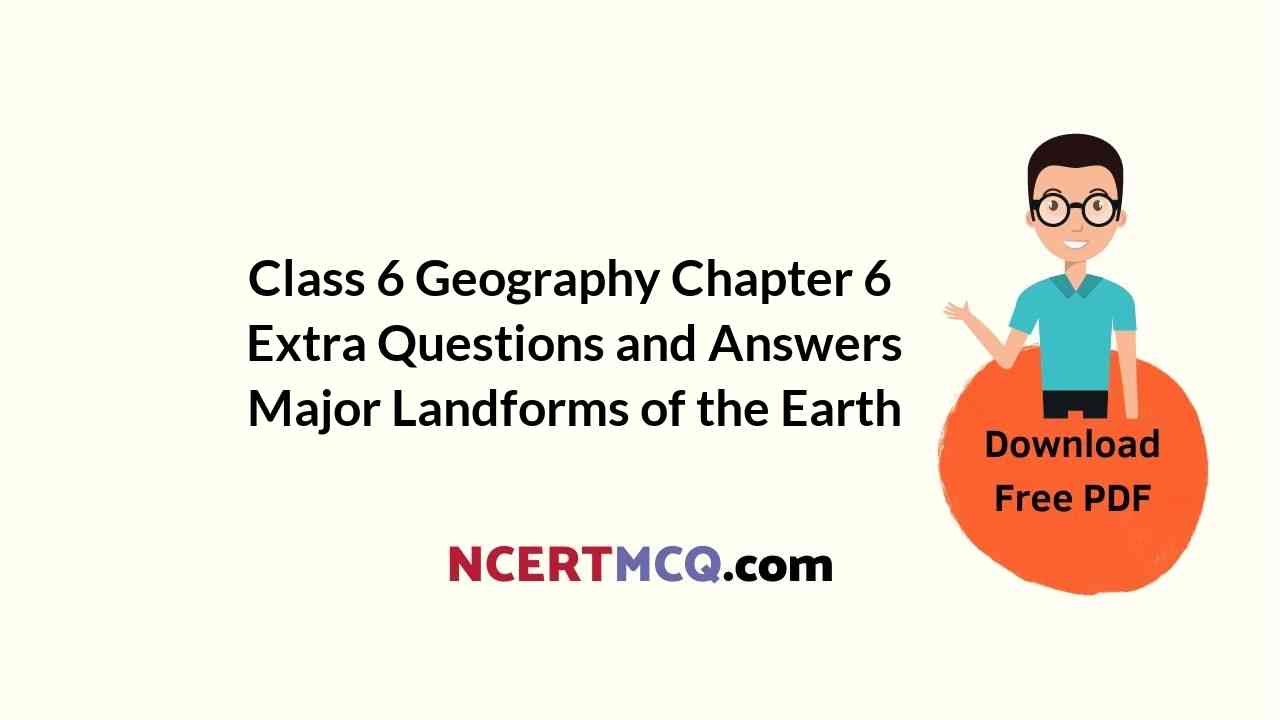Here we are providing Online Education for Class 6 Geography Chapter 6 Extra Questions and Answers Major Landforms of the Earth was designed by subject expert teachers. https://ncertmcq.com/extra-questions-for-class-6-social-science/
Online Education for Major Landforms of the Earth Class 6 Extra Questions Geography Chapter 6
Class 6 Geography Chapter 6 Extra Questions Question 1.
What do you mean by internal process?
Answer:
Internal process are those processes that originate under the earth’s surface.
Major Landforms Of The Earth Class 6 Extra Questions Answers Question 2.
What are the external forces?
Answer:
External process is the continuous wearing down and rebuilding of the land surface.
Major Landforms Of The Earth Extra Questions Question 3.
What is a glacier?
Answer:
The permanently frozen river of ice is called the glacier.
Major Landforms Of The Earth Class 6 Worksheet Question 4.
Define the term erosion and deposition.
Answer:
Erosion: Transportation of eroded material by river, wind, ice etc. is called the erosion. Levels down the elevated landforms of the earth.
Deposition: The dropping of material which has been picked up and transported by wind, river or ice. It fills up of the depressions of the earth’s surface.
![]()
Class 6 Geography Chapter 6 Extra Questions And Answers Question 5.
How are the plateaus useful to Mar?
Answer:
Plateaus play a very significant role in our life. They carry a great importance for human beings. Following are the major significances of plateaus.
They are made up of very old rocks, which have many mineral deposits. Man use these minerals for their own profit. Therefore, some plateaus like African plateau, Australian plateau are the major grounds of mining.
Plateaus have fertile soils which support agriculture. For example, Deccan plateau is rich in black soil, therefore it became the major cotton-producing centre of India.
Class 6 Geography Chapter 6 Question Answer Question 6.
Give a brief account on plateaus.
Answer:
A plateau is an elevated and flat-topped tableland which stands above the surrounding areas. A plateau have steep slopes on each sides. Their height varies from a few hundred metres to several thousand metres. Plateaus are found on each continents.
Some plateaus lies between the mountain ranges and some lies at the foot of the mountains. These plateaus are called the inter- montane and piedmont plateaus respectively. The Tibetan plateau is an example of intermontane plateau, while the Appalachian plateau is a piedmont plateau.
Importance: Plateaus are very useful to man because they are rich in mineral deposits. Therefore, many of the mining areas in the world are located in the plateau areas. Some plateaus are the home of several waterfalls. These waterfalls are widely used in the production of hydroelectricity.
![]()
Multiple Choice Questions
1. Which one of the following processes leads to the upliftment and sinking of the earth’s surface?
(a) External process
(b) Internal process
(c) Earthquakes
(d) Volcanoes
Answer:
(b) Internal process
2. Which one of the following is associated with the external process?
(a) Erosion
(b) Transportation of sediments
(c) Deposition
(d) Magma
Answer:
(c) Deposition
3. On the basis of elevation and slope, the landforms can be grouped as :
(a) Rivers, lakes and seas
(b) Coastal plains and valleys
(c) Mountains, plateaus and plains
(d) Plains, valleys and ridges.
Answer:
(a) Rivers, lakes and seas
4. These are the permanently frozen rivers of ice :
(a) Oceans
(b) Rivers
(c) Lakes
(d) Glaciers
Answer:
(c) Lakes
![]()
5. Which one of the following is different from the other three, with reference to the mountain ranges of Asia?
(a) Andes
(b) Ural
(c) Hindukush
(d) Pamir
Answer:
(d) Pamir
6. Which one of the following is the oldest fold mountain system of India?
(a) Maikal
(b) Aravali
(c) Satpura
(d) Shivalik
Answer:
(b) Aravali
7. Which one of the following is an example of the block mountains?
(a) Himalayas
(b) Aravali
(c) Vosges
(d) Kilimanjaro
Answer:
(a) Himalayas
8. Mt. Kilimanjaro and Fujiyama are formed due to the:
(a) Volcanic activities
(b) Earthquakes
(c) Landslides
(d) Plates movements.
Answer:
(a) Volcanic activities
![]()
9. Which one of the following is false about the usefulness of mountains?
(а) They cause air pollution
(b) They are the storehouse of water
(c) They have rich variety of flora and fauna
(d) They provide scenic beauty.
Answer:
(а) They cause air pollution
10. Which one of the following statements is truly define the word plateaus?
(a) Any natural elevation of the earth’s surface
(b) Large stretches of flat land
(c) An elevated flat-topped tableland
(d) Deep stretches of land surface.
Answer:
(c) An elevated flat-topped tableland
11. It is the oldest plateau of India :
(a) Malwa Plateau
(b) Chhotanagpur Plateau
(c) Western Plateau
(d) Deccan Plateau.
Answer:
(d) Deccan Plateau.
Important Definitions/Words:
→Internal process: The process that originates inside the earth, is called the Internal process, e.g. Valcano, Earthquake etc.
→ External process: The process which works on the earth’s surface, is called external process.
→ Mountain: A mountain is a high landmass with sharp sloping surface. It is generally higher than surrounding areas.
→ Plateau: It is an extensive and relatively flat upland. It can be 90 m to 9000 m high than the surrounding areas,
![]()
→ Plain: A flat and relatively low lying land is called the plain. Most of plains are formed by rivers and their tributaries.
→ Mount Everest, Kg (mt. Godwin Austen), Kanchenjunga and Nanga Parbat: Are the name of those mountains, whose height is more than 8000 metres.
